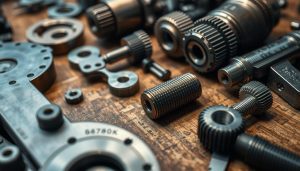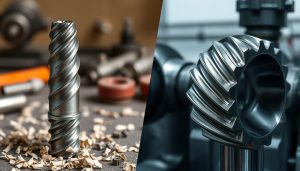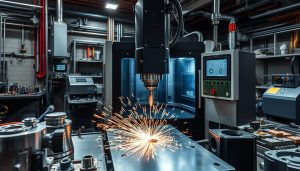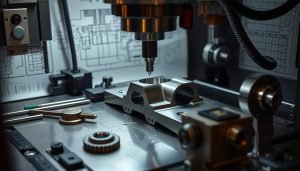Gears are the unsung heroes of modern machinery, playing a crucial role in enhancing mechanical performance and efficiency across a wide range of industries. From the intricacies of automotive engineering to the seamless operation of industrial equipment, these intricate mechanisms have become indispensable components in our technological landscape.
In this comprehensive exploration, we’ll dive into the diverse world of gears, uncovering their unique properties, and examining how their distinct types cater to various applications. By understanding the nuances of gear systems, we’ll gain valuable insights into how these engineering marvels contribute to the smooth and efficient functioning of the machines that shape our modern world.
Key Takeaways
- Gears are essential components that enhance mechanical performance and efficiency in a wide range of industries.
- Different gear types, such as spur, helical, bevel, and worm gears, possess unique properties that make them suitable for specific applications.
- Understanding gear materials and their strength characteristics is crucial for selecting the right gear for a project.
- Gear ratios and torque conversion play a vital role in the efficient operation of mechanisms.
- Factors like load-bearing capacity and durability considerations are essential when choosing the appropriate gear for a project.
Common Types of Gears
Gears are essential components in a wide range of mechanical systems, from automobile transmissions to industrial machinery. Understanding the unique characteristics and applications of different gear types is crucial for selecting the right solution for any project. Let’s explore the four most common gear types: spur, helical, bevel, and worm gears.
Spur Gears
Spur gears are the simplest and most widely used type of gear. They feature straight, parallel teeth that mesh together to transfer rotational motion. Spur gears are known for their efficiency, low cost, and ease of manufacture, making them a popular choice for a variety of applications, including automotive, industrial, and consumer products.
Helical Gears
Helical gears have teeth that are angled, or “helical,” relative to the gear’s axis. This design allows for smoother, quieter operation compared to spur gears, as the teeth gradually come into and out of mesh. Helical gears are commonly used in applications that require high-speed, high-power transmissions, such as in automobile differentials and industrial machinery.
Bevel Gears
Bevel gears are used to transmit rotational motion between intersecting shafts, typically at a 90-degree angle. The conical shape of the teeth allows for efficient power transmission, making bevel gears a popular choice for applications like automotive steering systems, machine tools, and aerospace equipment.
Worm Gears
Worm gears feature a spiral-shaped worm that meshes with a gear wheel, or “worm gear.” This unique design allows for a high gear reduction ratio, meaning a small rotation of the worm can produce a large rotation of the gear. Worm gears are commonly used in applications that require high torque and low speed, such as in automotive steering systems, conveyor belts, and industrial machinery.
Understanding the distinct properties and applications of these common gear types is essential for selecting the right solution for any mechanical system. By choosing the appropriate gear type, engineers and designers can optimize the performance, efficiency, and reliability of their projects.
| Gear Type | Characteristics | Typical Applications |
|---|---|---|
| Spur Gears | Straight, parallel teeth; efficient and cost-effective | Automotive, industrial machinery, consumer products |
| Helical Gears | Angled, “helical” teeth; smoother, quieter operation; high-speed, high-power transmissions | Automobile differentials, industrial machinery |
| Bevel Gears | Conical shape; transmit rotational motion between intersecting shafts | Automotive steering systems, machine tools, aerospace equipment |
| Worm Gears | Spiral-shaped worm that meshes with a gear wheel; high gear reduction ratio | Automotive steering systems, conveyor belts, industrial machinery |
Gear Materials and Strength
When it comes to gear manufacturing, the choice of materials plays a crucial role in determining the strength, durability, and performance of the final product. Gear designers and engineers must carefully consider the unique properties and characteristics of various materials to ensure that the gears can withstand the demands of their intended applications.
Common Materials for Gear Manufacturing
Some of the most commonly used materials in gear manufacturing include:
- Steel: Steel is a popular choice for gears due to its high strength, wear resistance, and ability to withstand heavy loads. Depending on the specific application, different types of steel, such as carbon steel, alloy steel, or stainless steel, may be employed.
- Brass: Brass is a versatile alloy of copper and zinc that offers good machinability, corrosion resistance, and a smooth finish. It is often used in low-to-medium-load applications, such as in household appliances or toys.
- Plastics: Advancements in polymer technology have led to the increased use of plastic gears in various applications. Plastics, such as nylon, acetal, or polyurethane, can provide lightweight, cost-effective, and self-lubricating solutions, particularly in low-noise and low-speed applications.
| Material | Strength | Wear Resistance | Corrosion Resistance | Noise Level |
|---|---|---|---|---|
| Steel | High | High | Good | Low |
| Brass | Medium | Medium | Excellent | Low |
| Plastics | Low | Good | Excellent | High |
The choice of gear material ultimately depends on the specific requirements of the application, such as the expected load, speed, environment, and cost constraints. By carefully selecting the appropriate gear materials, manufacturers can ensure that their products meet the necessary strength, durability, and performance standards.

How Gears Work in Mechanisms
Gears are essential components in a wide range of mechanical systems, playing a crucial role in power transmission and motion control. Understanding the fundamentals of how gears work is key to designing efficient and effective gear-driven mechanisms.
Gear Ratios and Torque Conversion
The primary function of gears is to convert rotational speed and torque between input and output shafts. This is achieved through the gear ratio, which is the relationship between the number of teeth on the driver and driven gears. By adjusting the gear ratio, engineers can increase or decrease the output torque while simultaneously reducing or increasing the rotational speed, respectively.
For example, a gear with a larger number of teeth will have a higher gear ratio, resulting in a lower output speed but higher output torque. This principle is widely applied in machinery, vehicles, and other gear-driven mechanisms to optimize power and efficiency.
Gear Arrangements for Optimal Efficiency
Efficient gear arrangements are essential for maximizing the performance and longevity of mechanical systems. Factors such as gear alignment, lubrication, and the use of complementary gear types can all contribute to improved gear efficiency. By carefully considering the gear mechanisms, engineers can minimize power losses and heat generation, ensuring the overall system operates at peak efficiency.
| Gear Type | Typical Efficiency Range |
|---|---|
| Spur Gears | 90% to 98% |
| Helical Gears | 92% to 98% |
| Bevel Gears | 88% to 95% |
| Worm Gears | 70% to 90% |
The table above provides a general overview of the typical efficiency ranges for various gear types, highlighting the importance of selecting the appropriate gear mechanisms for specific applications to maximize system performance and efficiency.
“Gears are the heart of any mechanical system, responsible for translating power and motion with precision and efficiency.”
How to Choose the Right Gear for Your Project
Selecting the appropriate gear for your project is crucial, as it directly impacts the load-bearing capacity, durability, and overall efficiency of your mechanism. When it comes to gear selection, there are several factors to consider to ensure you make the right choice.
Load-Bearing Capacity and Durability Considerations
One of the primary factors to consider is the load-bearing capacity of the gear. Depending on the demands of your project, you’ll need to choose a gear that can handle the expected loads without compromising its structural integrity. Additionally, the durability of the gear is essential, as it will determine the longevity and reliability of your mechanism over time.
When to Choose One Type Over Another
The different types of gears, such as spur, helical, bevel, and worm gears, each have their own unique advantages and disadvantages. Understanding the project requirements is key to selecting the right gear type. For example, spur gears may be more suitable for low-speed, low-load applications, while helical gears excel in higher-speed, higher-load scenarios.
By carefully evaluating the load-bearing capacity, durability, and specific project requirements, you can make an informed decision on the most appropriate gear for your application. This will ensure your mechanism functions efficiently, reliably, and with the desired performance characteristics.

“Choosing the right gear is essential for the success of any mechanical project. Careful consideration of load-bearing capacity, durability, and project requirements will lead to optimal performance and longevity.”
Why Choose Shixinproto for Gear Manufacturing
At Shixinproto, we take pride in our expertise in precision gear manufacturing. As a leading provider of custom gear solutions, we offer unparalleled quality, reliability, and customer service. Our state-of-the-art facility is equipped with the latest technologies, ensuring that every gear we produce meets the highest standards of precision engineering.
What sets Shixinproto apart is our commitment to delivering tailored solutions for our clients. Whether you require standard or custom gears, our team of skilled engineers will work closely with you to understand your unique requirements and deliver a solution that exceeds your expectations. From design to production, we leverage our extensive industry experience to ensure optimal performance and longevity for your gear-driven applications.
At Shixinproto, we understand that quality is paramount in the world of gear manufacturing. That’s why we have implemented a robust quality control system that ensures every gear that leaves our facility is free of defects and ready to perform flawlessly in your machinery. Trust Shixinproto to be your reliable partner in gear manufacturing and unlock the full potential of your equipment.





